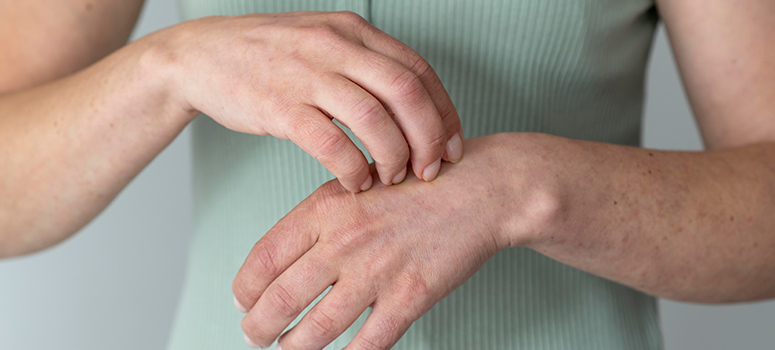Psoriasis is a common skin condition. It has been affecting people for a lot of years. The best part is that it can be successfully managed if it is diagnosed at early stages. However, patients with this condition usually delay visiting the doctor because they are unaware of the symptoms. Some do not even realise they have Psoriasis.
Erythrodermic Psoriasis is a rare autoimmune chronic skin disorder that can attack all human body organs. It shares the same characteristics with Psoriasis, but it is more serious, so much so that it affects all the layers of the skin.
The first step towards getting rid of this condition is knowing what it is, how it develops and how to approach it. This blog focuses on everything about Erythrodermic Psoriasis to help you understand it better to take timely action.
What is Erythrodermic Psoriasis?
Psoriasis is a common problem that a dermatologist can treat. It’s one of the most common non-contagious diseases affecting millions of people across the globe. It leaves red, scaly, and swollen skin. It occurs when the body’s immune system attacks healthy skin cells. This skin disease affects the inside and outside of the body, making it hard to diagnose at the time of the first presentation.
Erythrodermic psoriasis is a rare condition which is more severe than the usual plaque type of psoriasis. In this type of psoriasis, the whole body region with affected skin is covered with red and silvery scaly patches. In some cases, the patches may even crack if the areas are pressure-applied or handled roughly.
Erythrodermic Psoriasis, also known as Exfoliative Dermatitis, is a severe form of Psoriasis. It is also referred to as “Generalized Severe Plaque Psoriasis” or “Flare-up Psoriasis.” Erythrodermic refers to the redness of the affected area. It occurs when skin cells are accelerated to the extent that they lose their functionality, i.e., the ability to form new skin cells to maintain skin health and protect against infections. This type of psoriasis leads to acute inflammation of the whole area resulting in the formation of red, painful sores on the affected areas. It can mainly occur in people with pre-existing psoriasis and often has profound health implications.
Here are its causes and symptoms to help you understand this skin condition better.
What are the Erythrodermic Psoriasis causes and symptoms?
Erythrodermic Psoriasis Symptoms
The symptoms of erythrodermic psoriasis can vary from one individual to another. Some patients may complain about extreme itching on their skin, while others cannot tolerate even slight touch. Erythrodermic Psoriasis is extremely painful and uncomfortable. Its symptoms include:
- Itchiness
- Burning sensation
- Dryness of the skin
- Thickening and peeling of the skin and blisters.
The itching causes patients to scratch their skin incessantly, resulting in bleeding or even irritation of the palms that could lead to infections and fungal and bacterial skin infections.
Some signs of Erythrodermic Psoriasis are confusion, drowsiness, jaw pain, extreme sleepiness and fatigue and Sore throat. These symptoms, if not treated on time, may prove fatal. So to prevent this from happening, you must immediately contact a dermatologist for effective treatment.
What are the complications of this skin condition?
Erythrodermic Psoriasis affects the body’s ability to sweat and maintain body temperature. Hence people with this skin condition develop hypothermia. This skin condition also affects electrolyte levels, which leads to dehydration. Some people also experience fever, chills, and fluid retention in the feet and ankles.
Besides these health issues, people who suffer from Erythrodermic Psoriasis are prone to heart failure, septicemia, and Pneumonia, to name a few.
How is it treated?
Until today, there is no cure for Erythrodermic Psoriasis, but with the help of treatments, the discomfort can be minimised and prevented. Some of the commonly known erythroderma treatments include:
- Topical ointments such as corticosteroids and retinoids.
- Hypoallergenic moisturisers and cool compresses.
- Nonsteroidal anti-inflammatory drugs (NSAIDs).
- Immunosuppressants like cyclosporine or methotrexate.
- Disease-modifying antirheumatic drugs (DMARDs).
- Oral retinoids.
- Biologic therapies.
Also, some treatments are a big no in the case of Erythrodermic Psoriasis. Some of those treatments are:
- Coal tar products
- Oral corticosteroids
- Phototherapy
Before going for any of these treatments, you should see a dermatologist and let them check the severity of your condition. They will then be able to prescribe a course of medications or suggest a treatment.
How can it be prevented?
The best way to keep Erythrodermic Psoriasis at bay is to continue the treatment suggested by your dermatologist until it gets better. You can consider making these changes in your lifestyle to prevent flare-ups.
- Reduce alcohol consumption
- Manage stress
- Apply sun protection
- Quit smoking
- Visit your dermatologist regularly to check the progress.
Deal with the rare kind the right way!
Erythrodermic psoriasis needs immediate medical attention. If you want to connect with a top dermatologist or learn more about Erythrodermic psoriasis, visit the Skin and Hair Academy. This portal has dermatologists across India and has insightful content about all types of skin and hair conditions curated by expert dermatologists themselves.














